User Interviews: The Untold Story of User Experience

Understanding the user perspective is crucial for improving your product design and UX experience. It is something that most companies need to take into consideration. Statistics show that 88% of companies that provide the best customer experience define customer mapping as a critical differentiator.
One of the best ways to understand users is to talk with them. User interviews can generate a lot of interesting insights and data. They aren’t too expensive to conduct, making them a good option for many businesses.
Nowadays, thanks to the power of the Internet and various video conferencing tools, you have the flexibility to run such studies online, which helps you save a lot of time and money.
Investing in a powerful user testing platform like our PlaybookUX can make these studies even more accessible. It’ll help you schedule, automatically record sessions, and allow you to process and analyze data quickly. If you want to see how PlaybookUX works, sign up for a 7-day trial.
Of course, a user interview isn’t just a conversation. You shouldn’t treat it as such. You need to understand what you want to achieve and get ready. How to do that? Well, you’re in the right place – we’ll give you all information you need in this article. Let’s start with defining what a user interview is.
What is a user interview?
A user interview is a technique you can use to gather valuable customer feedback. The method is closely related to the well-known Critical Incident Technique – created in 1954 by a social scientist John Flanagan – which is a procedure for systematically obtaining information about the interactions users have with a product.
The basic idea behind user interviews has been borrowed from journalists and media outlets. The researcher asks the participant various questions concerning the topic at hand.
User interviews are conducted using a one-on-one model, which is how they differ from focus groups. To be precise, sometimes there may be several interviewers – some of them take an active role in the conversation, and others take notes so the person who leads the interview can concentrate on asking questions.
However, there’s always only one respondent, which helps create an environment that allows researchers to get in-depth feedback and concentrate on that person’s perspective.
Why conduct user interviews?
User interviews are one of the core user research methods. They’re a great way to get customer feedback to validate an idea quickly. They can also allow you to learn what users think about an application, website, or service.
You can conduct user interviews during several different stages of project development. Employing them at the very beginning of the design phase can be an excellent idea – they can allow you to understand better who the product is for and what features it should offer, explore concepts, or create journey maps.
However, later on, you can also employ user interviews to guide a solution in a specific direction and improve it. Finally, interviewing tends to work very well in agile teams.
User interviews complement greatly to other research methods. You can use them to gather feedback regarding data acquired via other studies. For example, you can conduct card sorting or tree testing and interview the research participants to get additional information and context. This type of conversation is known as a contextual interview.
The benefits of interviewing users
There are several reasons user interviews are worth conducting:
- User interviews are very easy to conduct – you don’t need complex tools or people with competencies that are hard to find
- They require minimal setup – if there aren’t too many participants, you can do user interviews very quickly, which makes them the perfect UX research method for when you don’t have much time
- They aren’t expensive – if money is an issue, interviewing users is one of the best ways to gather insight because it’s cost-effective
- They are flexible – you can use them to get information on various topics, such as user behaviors, their feelings, impressions, and similar
- User interviews can reveal additional details and context – one-on-one conversations are a great environment to get in-depth data
- You can always do a follow-up – if something isn’t clear, it’s relatively easy to schedule a follow-up conversation or send an e-mail with a couple of questions
The drawbacks of interviewing users
There are also several problems and drawbacks you should be aware of:
- The quality of data depends on the skills of the interviewer – the soft skills of the person conducting the actual interview will play a significant role in the data usefulness
- Possibly time-consuming – if the number of participants is high, user interviews can take a lot of time
- People don’t always tell the truth – what people do can differ from what they say, and some test participants may be unwilling to answer some questions
- Humans don’t have a perfect memory – sometimes we misremember things, or our memories are incomplete, and this can skew test results
- Different people notice different things – contributors will give you answers based on their perceptions which may be flawed
What do you need to conduct user interviews?
You don’t need much to conduct user interviews. If you want to talk in the real world, you’ll need a means of transport, along with a notebook, a tablet, a laptop, or even a smartphone so you can take notes.
If you plan to conduct interviews online, you’ll need specialized software. You can use standard video conferencing software, but the best option is investing in a user testing platform such as our PlaybookUX. Our solution will help you conduct the interview and also analyze the acquired data.
You’ll also need to have well-developed soft skills – or a team member who can conduct a conversation in a way that’ll allow you to get the most out of it.
The best places to conduct user interviews
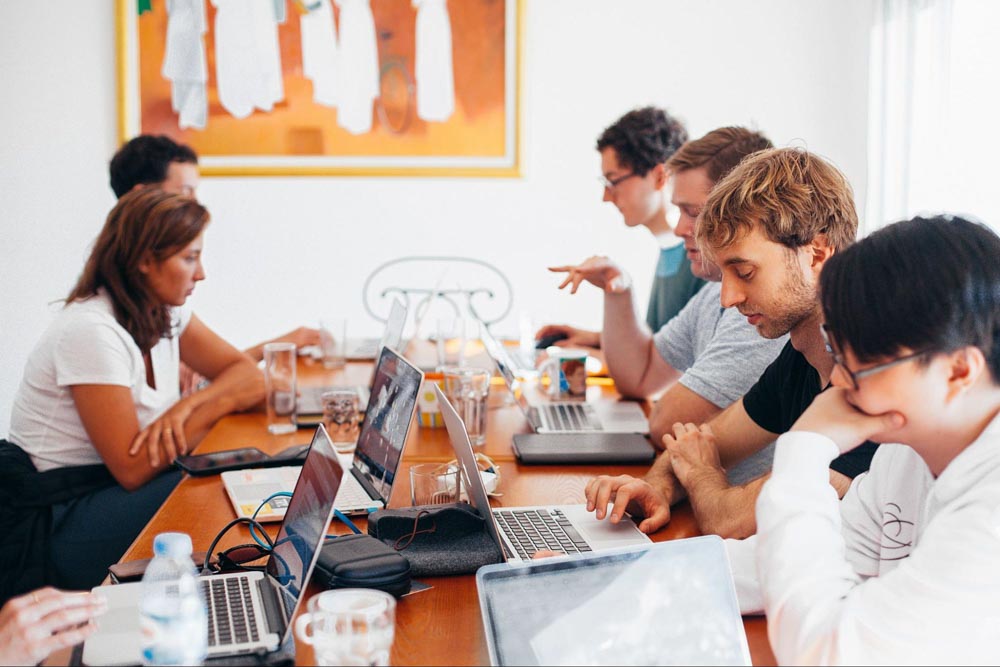
You can run user interviews in several different environments. You – or researchers from your team – can go to the user’s home or office and have a conversation in person. You can also conduct interviews at your business location, such as your company office or lab.
You can also talk via phone or a video call. Due to the Covid-19 pandemic, remote work has become the norm in many industries, and people have become accustomed to online conferencing software.
This approach is usually the least time-consuming option for both parties and gives the test participant the comfort of staying in a familiar place.
Of course, online interviews also have some drawbacks, such as technical issues. A tried and tested software solution – such as a PlaybookUX, is a good idea.
Key elements of great UX user interviews
Several things define an excellent user interview:
- It’s honest – don’t lie to your test participants unless it’s part of test plan
- It’s friendly– try to build rapport with the other party, keep things casual but also authentic
- It’s goal-oriented and planned – user interviews aren’t everyday conversations. You conduct them for a reason and with a plan in mind
- It’s not rushed – don’t rush the interview. If you don’t have time to do it properly, do it on a different occasion
- It’s well-documented – the best conversation won’t be of much use if you don’t have good notes from it or another way to document it and gather data for analysis
- It’s conducted by someone who knows how to talk – soft skills are a must when it comes to user interviews. The researcher’s ability will affect the quality of the data
7 best practices for user interviews in 2022
Here are several steps you can take to get ready for the interviews and execute them in a way that gives the highest chance of success.
1. Set a clear goal for the study
You should never conduct interviews without a specific plan and objective in mind. Meet with your team and the company stakeholders, and define clear goals you want to achieve with the interview.
Prepare a list of things to learn. For example, you might want to check if a specific task, such as entering customer data, works as it should. If it doesn’t, specify what you need to change. Try to be precise but don’t limit your goals too much.
2. Find an optimal sample size and recruit the right people
When you know what you want to achieve, consider what kind of people you need to talk to. If you haven’t defined them already, create so-called personas, fictional people representing your potential customers.
Also, evaluate how many conversations you need to have to get the right data quality. One rule of thumb you can use here is interviewing five people per persona – it will help ensure you have a large enough sample base.
However, be aware that using that method might require you to conduct more conversations than necessary for the project. The best idea is probably to take note of saturation – interview people until you can see specific themes and issues emerging from most conversations.
3. Create a script and list of questions beforehand

Make sure to create a script for the conversation and complement it with a comprehensive list of questions. Try to anticipate the conversation flow. Think about how your interviewee might respond, and then create follow-up questions. You should always have more questions ready than you think you’ll have time for. You never know precisely how much time an interview will take.
4. Be sure to make the test participant feel comfortable
Start the conversation by introducing yourself, or have a call beforehand to get to know the person before the discussion. Describe the goal of the study. Build rapport with the other party during the interview, and make sure they feel comfortable. Don’t be too focused on your tasks – be sure to ask some simple “opening” questions, such as “how are you today?” or “how is your day?”. Be friendly and easy-going. Use common language.
5. Try avoiding vague, leading, or directed questions
Make sure not to ask leading questions or directed questions. For example, don’t ask, “Why do you like our solution?” if the other party didn’t suggest they do. Instead, consider asking, “Do you like our solution?” and follow up with another question. Be specific – avoid ambiguity if you can.
6. Open-ended questions are good
Don’t use too many closed questions – i.e., ones that elicit a yes or no answer. One of the greatest strengths of user interviews is that they allow you to converse with an actual human being. It enables you to learn more about the context of tasks – users’ feelings and thoughts. You can gather any additional data, so use that to your advantage. Employ and ask open-ended questions.
7. Provoke dialogue
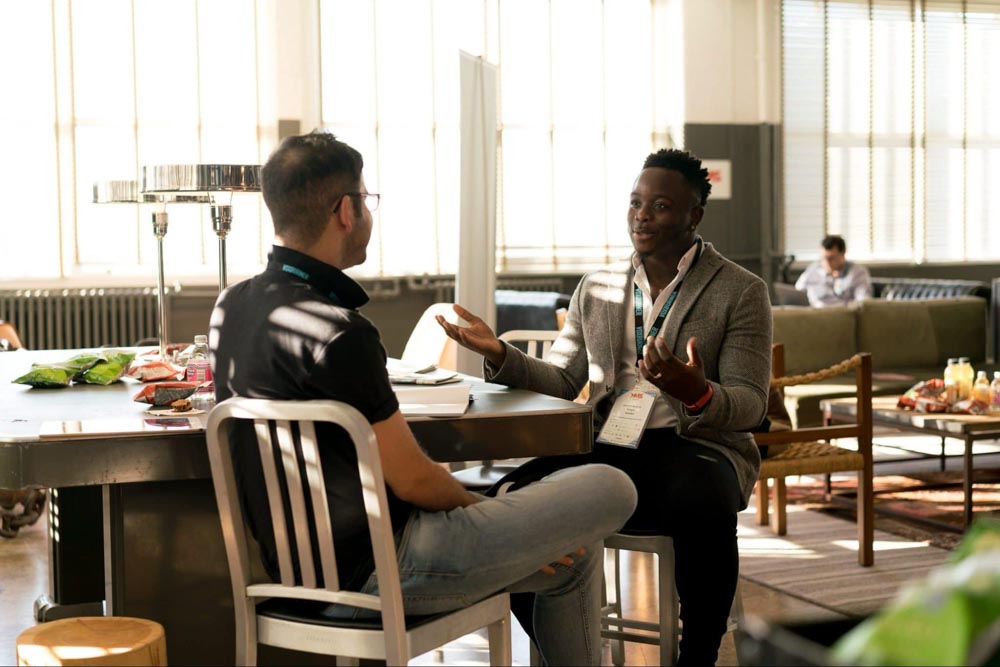
Don’t interrupt the interviewee, but prompt them for additional details. Ask follow-up questions, and show interest in the conversation. Try to provoke a dialogue that will be interesting to both sides.
What to look for as you analyze user research data
That’ll depend on the goal you choose for the study. In general, you should take note of:
- Themes and patterns – if the same thing comes up in several interviews, it’s almost surely worth looking into
- Pain points – things that cause problems when users interact with your solution
- Elements users liked and disliked – sincere emotions can give you quite an information about your solution
What you can learn from user interviews
User interviews can give you valuable insights into how users think and feel, as well as their needs and preferences. You’ll be able to see whether your plans and design fit the expectations of your potential customers. If they don’t, you can identify pain points and use your acquired interview data to guide your team and implement necessary changes.
User interviews can provide you with both qualitative and quantitative data. Still, the focus is clearly on the first type – you usually gather insights via open-ended questions which provide context that allows you to understand the decisions and emotions of the user.
You can also get some quantitative – numerical – data, but it has more value in a broader context. For example, suppose you conduct many interviews during a specific project phase. In that case, you can use the information to create datasets that allow you to understand various things about your customer base better.
How to conduct user interviews with PlaybookUX
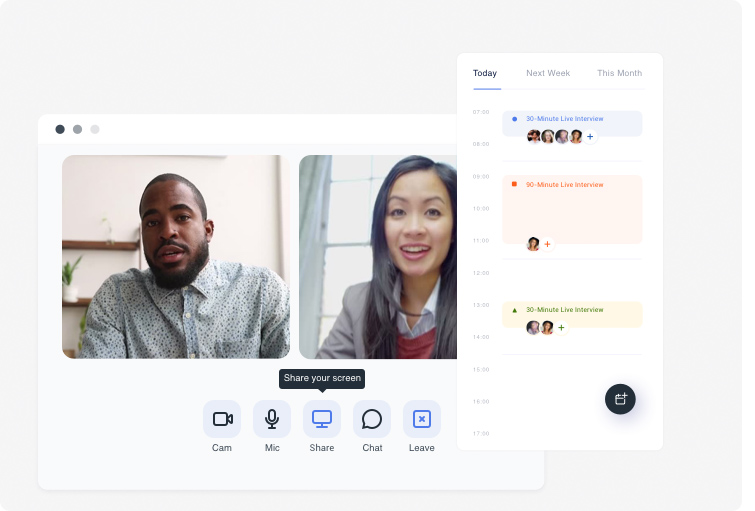
PlaybookUX allows you to conduct moderated interviews online. You can see and hear the test participant in real-time and talk to them almost as if you were in the same room. You can also share your video camera or screen – or let participants take control of your own – and show websites, products, and elements of your solution that you want to discuss. You can invite other people to take notes or actively participate in the conversation.
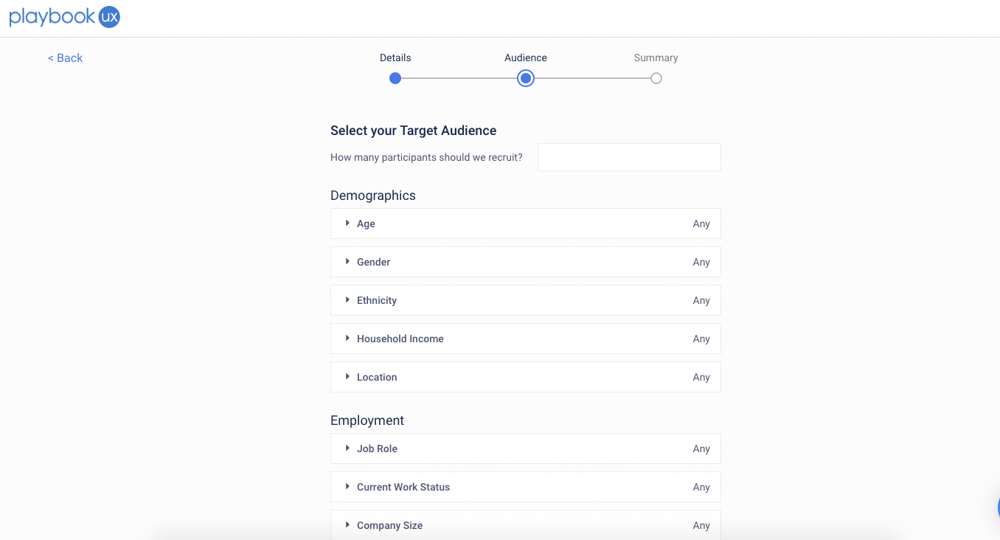
Starting a user interview with PlaybookUX is a simple enough process. After logging in to your account, select the “Moderated” section and specify the session length. You can choose 30, 60 or 90 minutes. Fill in the name and description of your project and define the number of test participants and their demographics.
Submit the project and set up your calendar – schedule conversations, specify your availability, the time between bookings, etc. When you finish everything, you’ll get e-mail notifications, invitations to planned discussions, and a Zoom video conference link. When there are more than 24 hours to a session, you can reschedule it without additional cost. You can also cancel at any time – but in this case, you’ll get billed as if the session happened.
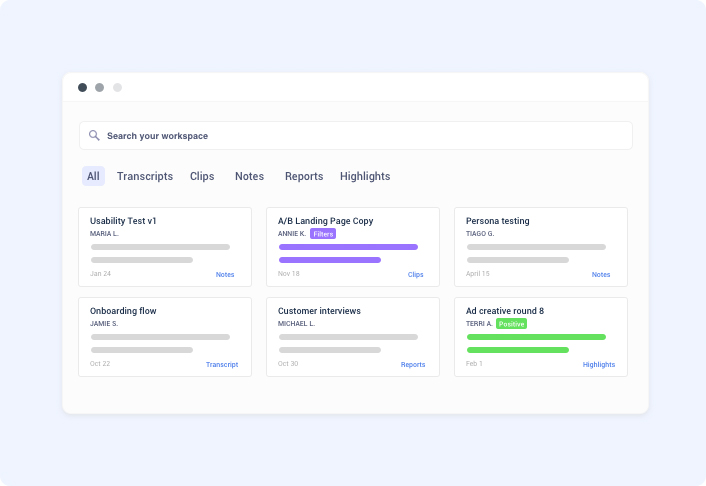
After the sessions, the recordings will be automatically uploaded to our platform and transcribed. You can then analyze the material, take further notes, isolate clips, create highlight reels, and draw conclusions.
Why choose PlaybookUX
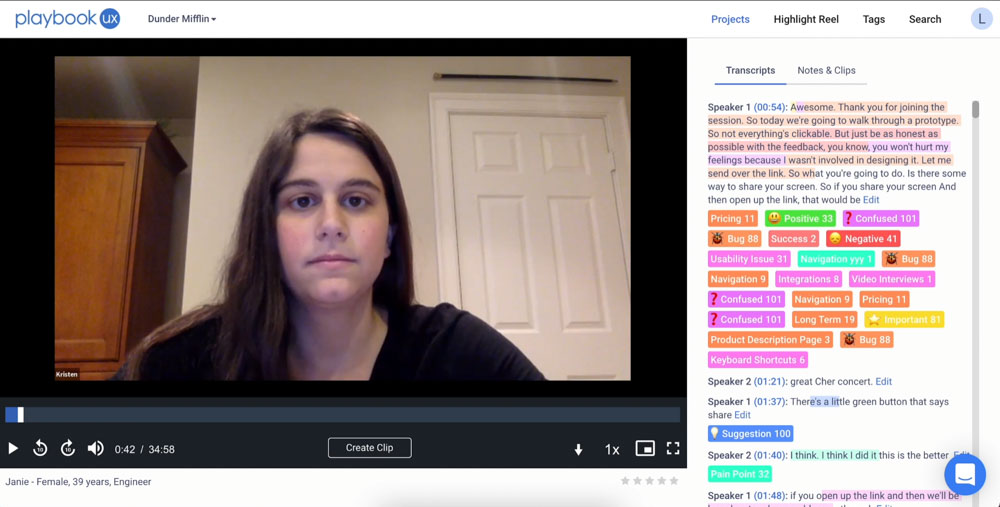
Our PlaybookUX is a great user research platform that allows you to conduct moderated interviews to gather insights about your product.
You can recruit participants through our platform, so interviews are straightforward to set up. Many filtering options allow you to specify your test group’s demographics and other details. Moreover, PlaybookUX sessions are automatically recorded, so you can be sure you have all the essential information you might need.
You don’t even need to create notes during the conversation. You can analyze it, draw conclusions and infer various insights later – whenever you have the time.
Our customer feedback features give you an easy way to ask follow-up questions and get details you might have missed during the initial conversation.
The platform also makes it easy to find the data you need at a given moment, which can be a big help during the analysis phase. We have a powerful search feature with automatic indexing and a tagging system that you can use to organize your work however you choose.
PlaybookUX can even replace a research repository – all your essential data is in one place, and you don’t need to invest in additional licenses.
User interviews: The bottom line
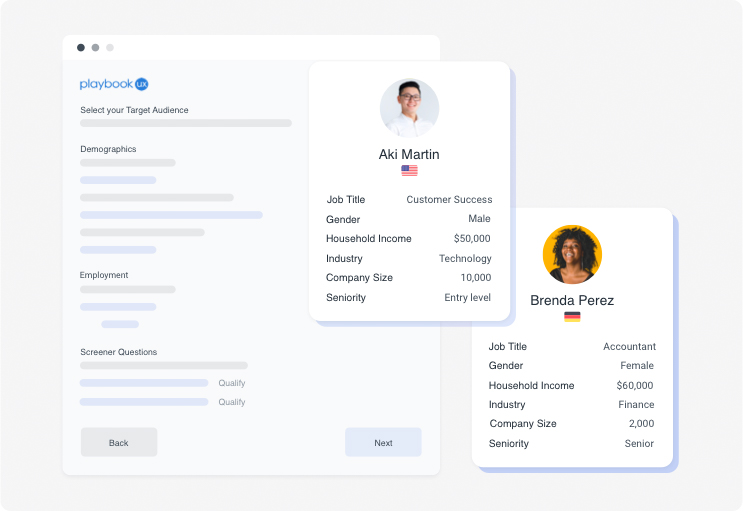
An interview is one of the best ways to understand the potential users of your product – learn about their thoughts, feelings, motivations, and problems. It allows you to acquire data that’s more in-depth than what comes from a survey or an unmoderated test.
The great thing about interviews is that they come naturally to most people, assuming the person doing the interview is prepared, skilled enough, and can overcome some hurdles and problems that might arise. You can start gathering important insights quickly and easily.
You can invest in a comprehensive user testing platform if you want to conduct online interviews. Our PlaybookUX is a great choice here. It will make the entire process easier and take some of the burdens off your shoulders by automating many tasks, such as transcribing or scheduling tests.
It’ll also help you with analysis thanks to great visualization options, search features, and a robust tagging system. Sign up now and use our 7-day free trial – you have nothing to lose and quite a lot to gain.
User interviews: FAQ
Where can I find interview users?
The best way to do that is to use user testing software that’ll allow you to find the right people for your particular project.
How do you plan a user interview?
First, you need to define the goal of the test – decide what you want to accomplish through it. Then plan and write a script and all the questions you want to ask. After that, it’s just a matter of finding the right contributors, testing your technology and software, and scheduling the study.
How do you write UX interview questions?
Always keep the goal of your study in mind. Start by writing a script for the interview, and divide questions into groups focused on specific topics. Avoid ambiguity, and make sure your questions aren’t suggesting answers.
How do I start a UX interview?
In general, it’s a good idea to introduce yourself and start the conversation with a simple opening question. For example, “Hi, I’m John. How are you today?”. In the beginning, your goal should be to overcome the awkwardness that is typical of such situations and find a way to build a connection with the other party.
How can we ensure a product meets a user’s needs?
You can employ usability testing methods – moderated tests, unmoderated tests, tree testing, card sorting, surveys, and user interviews.
Speak to high quality people
